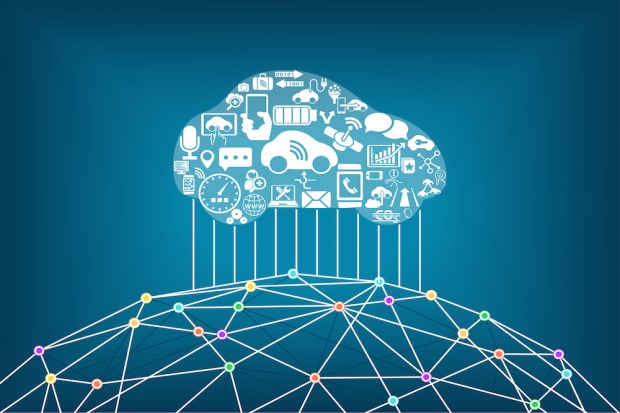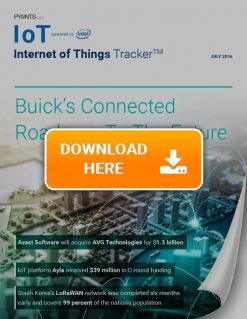Buick’s Connected Roadmap To The Future

Road. Trip. IoT’s hitting the road. And Buick’s Dave Spencer and OnStar’s Rich Martinek have big plans for the trip, including integrated rewards programs and enhanced central operating systems. Catch that, along with all of the “smart” IoT news and 90 IoT player profiles, in the July IoT Tracker.
It can be both a blessing and a burden being America’s oldest (active) automobile brand. With age comes nostalgia and descriptions that include adjectives like venerable. Nostalgia and venerability don’t exactly make cars fly off a new car lot. So for Buick, a brand that has produced nameplates like Roadmaster, Skylark and LeSabre, the blessing of a long life – while contemporaries like Mercury and Pontiac have long since hit the highway to heaven – is also the burden of popular perception.
Cutting-edge is not intuitively synonymous with Buick. And so, the brand’s recent technological push may come as a surprise to perspective car buyers. Despite the brand’s vintage connotation, it has been steadily carving out a place for itself as a leader in the connected motor vehicle space. That’s right – Buick has entered the IoT race, and they plan to put the pedal down.
PYMNTS recently spoke with Dave Spencer, Buick’s Advertising Manager, and Rich Martinek, Global OnStar’s Senior Marketing Manager, about Buick’s efforts at breaking away from an antiquated image and embracing the future of connected living.
Becoming the “new” Buick
Despite Buick’s continued commitment to innovation, the brand’s retro image remained a somewhat stifling force until 2014. It was at this time, Spencer explained, that the company launched an advertising campaign to shed off the public’s “notion of false familiarity.”
“People really didn’t know what a Buick was. We had all new nameplates, redesigned vehicles, and while we had very high awareness, we had very low familiarity,” he said.
The ads took a “hidden in plain sight” approach to showcasing Buick’s modernity. One spot, for example, shows a grandmother getting picked up by her millennial grandson in his new car. After taking in the sleek ride, she says, “I thought you bought a Buick,” to which he replies, “This is a Buick!”
In addition to attempting to shatter consumers’ preconceived notions of what Buicks look like, the ads marked an orchestrated passing of the Buick torch from older drivers to their younger, presumably more technologically engaged counterparts. But although the brand’s sleek, updated aesthetics were highlighted throughout the ad campaign, Buick’s transformation has been more than skin deep.
From out-of-date to online
Prior to releasing their self-aware ad campaign, the GM/Buick team determined they needed a revitalizing, cutting-edge feature to propel their cars into the 21st century and to secure a reputation as a tech-driven brand.
GM was looking at “shaking up what people were thinking about the brand, and having a ‘wow’ feature that would get them to take notice and really consider, at that point, the Buick brand,” Martinek explained.
After some market research, the company decided to ramp up tech features when designing its cars based on the fact that 75 percent of consumers said they would “reconsider a brand or consider a brand” if it offered a state-of-the-art feature, like in-vehicle Wi-Fi.
GM’s plans to equip Buick cars with internet access was “universally well-received,” Spencer recalled.
“From a General Motors standpoint, we looked at this as a huge opportunity and invested in it in a significant way, as we rolled it across many of our brands and many of our vehicles over a very short period of time. Most vehicles got it within six months of when we started to launch,” explained Martinek.
Pushing the limits of automotive connectivity
As GM set out to technologically jazz up Buick’s offerings, it instated not only Wi-Fi access, but also equipped the cars with 4G LTE connectivity via its OnStar subsidiary — essentially turning the vehicles into mobile IoT devices.
OnStar — the subscription-based service activated by an in-vehicle blue button that has become a fixture for many GM car owners since its launch in the 1990s — started as a hands-free communication system that drivers could use to, among other tasks, make calls, receive vehicle diagnostics and make reservations. Despite OnStar’s numerous features, GM soon discovered that it was being used for one purpose far more than any other: navigation. More often than not, drivers activated the service in search of coffee shops, restaurants and retail stores.
According to Martinek, the brand saw driver demand for directions as an opportunity for extending its cars’ connectivity. The result was “AtYourService,” an integrated consumer rewards program that is now available to Buick’s OnStar subscribers.
“We saw the opportunity that, if someone calls in and they’re looking for a specific thing like Dunkin’ Donuts, then we can deliver a coupon to them,” Martinek explained. “So, if they’re going to Dunkin’ Donuts anyway, we not only can help them find that location, but we can also give them a dollar off a coffee or whatever the current offer may be. So we’re already guiding them where they need to go – the thought now is how do we add additional value when they get to that destination?”
When AtYourService first launched, users would receive rewards via email after requesting navigation to a participating merchant. Now, the service can be accessed within the MyBuick app, a central program that, in addition to providing AtYourService and auto-focused content, enables users to locate, unlock and even remotely start their cars.
Fueling up for the future with IoT
While drivers can currently control the MyBuick app and its AtYourService feature from their smartphones or tablets, GM plans to further integrate the technology into the Buick vehicle.
By the end of 2016, the company is planning to make the MyBuick app available for direct download through the IntelliLink system, the built-in “infotainment system” that drivers can access through their cars’ radio screens.
GM is also ramping up efforts to make its cars commerce-connected through enhanced integration of its central operating system.
“The additional thing we’ve been working on that’s probably coming sometime early next year is the ability for you to start to be able to transact while you’re in the vehicle,” Martinek said.
This means that once consumers receive offers from AtYourService, they’ll be able to redeem them while still in their cars. For instance, when drivers start their cars in the morning, they might receive a coupon for a coffee. Then, through the IntelliLink system, they will be able to order their coffee, use the coupons, and pick up their ready-to-go orders (without having to wait in line).
Ordering coffee and using coupon codes, however, is only the beginning, Martinek said.
“We’ve got 7 million connected cars on the road today, and we have an opportunity when we work with partners and merchants to connect our drivers with the ability to do a lot of things: drive offers, drive content, and also, longer term, help simplify purchase and navigation to these different merchants,” he explained.
Although the brand may still be a blast from the past for some, one thing is clear: Buick’s current IoT push is contemporary and connected.
To download the Tracker, click the button below:

About the Tracker
The PYMNTS.com® Internet of Things Tracker, sponsored by Intel®, showcases companies that are leading the way in all aspects of the Internet of Things. Every month, the Tracker looks at what these companies are doing across the ecosystem and in six categories: Devices; Infrastructure; Payments; Security; Software; and Data.
